








MIDWEEK UPDATE 30 NOVEMBER 2016THIS WEEK IN MIDWEEK UPDATE Notice Board…….Plan Your Weekend……..Forthcoming Events Aviation News………. Worldwide Incidents and Accidents This Week in Aviation History………Advertising Rate Card  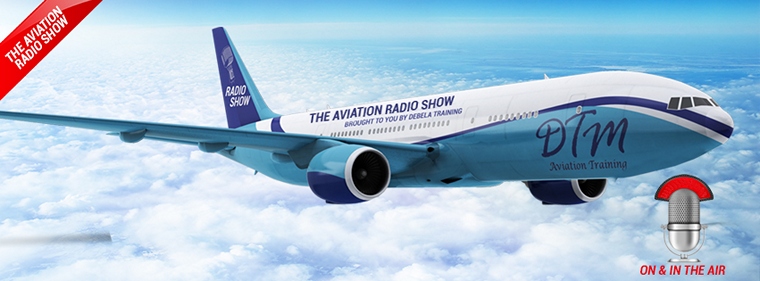 The Aviation Show Podcast now on Pilot's Post This week's Topic: AME (Aircraft Maintenance Engineer) Apprenticeships. For a recording of the life broadcast go to: www.debela.co.za/aviation-radio-show  3-4: SAC ACE of Base Vereeniging airfield. Contact Annie Boon e-mail: chunge@mweb.co.za  7: EAA Chapter 322 monthly meeting, Dickie Fritz Moth Hall Edenvale. Contact editor@afskies.co.za 7: International Civil Aviation Day (ICAD). Contact Mark Swarts e-mail: swartsm@caa.co.za Cell: 082 878 0875 12: Crete 2 Cape - Vintage Air Rally. Baragwanath 11:00 Arrive direct from Botswana. 13: Blue Mountain Valley Airport. 14: Parys Airfield 07:00 - 9:00. 14: Bloemfontein 10:00 - 12:30. 14: Gariep Dam. 15: Plettenberg Bay Airfield. 16: Stellenbosch Airfield 11:00 Grand Air Arrival. Sam Rutherford. sam@prepare2go.com www.VintageAirRally.com 28: All welcome to our annual St Francis Field fly in at FACT. Free breakfast snack and coffee for all visiting pilots arriving by air.On line or SMA Wx available. Contact Barry Culligan for details on 083 611 3333 or get info from the pilots section of our website 21 - 22: SAC Judges' Trophy Tzaneen. Contact Annie Boon e-mail: chunge@mweb.co.za 28: Rand Airport Challenge. Rand Airport. Contact Frank Eckard e-mail: frank.eckard@mweb.co.za cell: 083 269 1516  TREND IN THE CAASA AVIATION ACTIVITY INDEX (CAAI) - 3RD QUARTER 2016 During the recent Africa Aerospace & Defence Exhibition, held at Waterkloof Air Force Base, the Commercial Aviation Association of Southern Africa (CAASA) launched a composite index of the level of aviation activity in South Africa (for the second quarter of 2016). The index for the 3rd quarter has now been compiled. 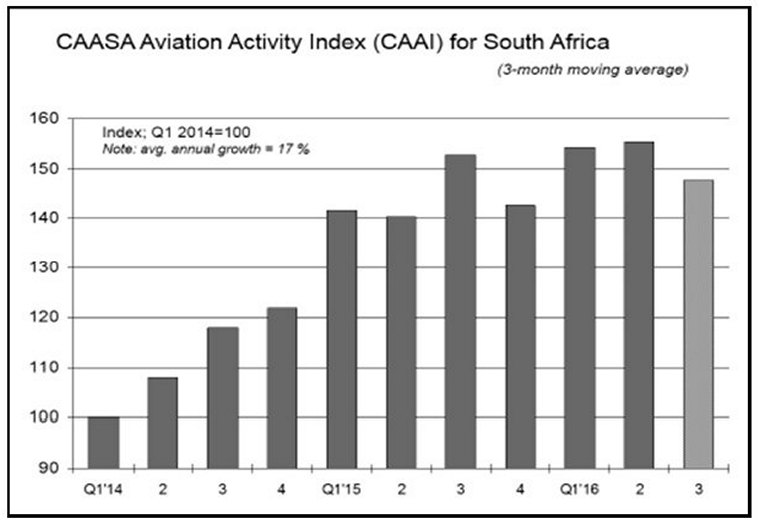 Summary of key trends depicted by the CAAI: 1. Despite a modest decline since the 2nd quarter of 2016, the overall index for the 3rd quarter shows that commercial aviation activity in South Africa is alive and well and outperforming most other sectors of the economy by a considerable margin. On the basis of a 3-month moving average, the CAAI has increased by more than 47% since the first quarter of 2014. This represents an average annual rate of increase of 16.8%. In comparison, the country's GDP (weighted according to the quantity/nominal value ratio of the CAAI) only increased by 4.6% per annum, on average, over this period. 2. The main drivers behind the sterling performance of the CAAI since 2014 have been the value of imports of aircraft & spares, as well as the value of exports of aircraft. This combined valued reached a level of R5.2 billion during the first three quarters of 2016, compared to R3.7 billion during the first three quarters of 2014. Growth rates for the different categories over these two periods are as follows: • Imports of helicopters: 116% • Imports of airplanes (under 15T): 46% • Imports of aircraft spares: 36% • Exports of aircraft: 38% 3. Since 2014, growth in air traffic movements (ATMs) at airports managed by ACSA has been muted, but nevertheless positive. The group index for this indicator increased by a modest 4.9% over this period. George and O R Tambo have witnessed the strongest growth in ATMs amongst the ACSA airports. 4. Growth in ATMs at key non-ACSA airports has been significantly stronger since the 1st quarter of 2014, namely 21.2%, but activity has tapered off over the past three quarters. Rand airport has been the star performer amongst this group. Rationale & methodology The rationale behind the decision to design the Caasa Aviation Activity Index (CAAI) was, firstly, the recognition of the indispensable role that commercial aviation plays in facilitating the rapid transport of decision-makers and cargo in all spheres of society. Secondly, CAASA has identified a need to contribute to the knowledge base of conditions in the domestic aviation industry by forging a number of key indicators into a composite index, weighted in terms of their perceived contribution to the general trend in commercial aviation. A total of 25 different indicators were selected for inclusion in the CAAI, classified in terms of the following seven groups: • Value of imports of helicopters • Value of imports of aeroplanes (of a mass less than 15t) • Physical quantity of imported aircraft • Value of imports of aircraft spares • Value of exports of aircraft (of a mass less than 15t) • Air traffic movements at six ACSA airports (including Johannesburg, Cape Town & Durban) • Air traffic movements at seven key non-ACSA airports In combination, the CAAI provides an objective & balanced gauge of the level of economic activity in the commercial aviation industry, compared to a base period. Due to the short-term volatility inherent in purchasing and selling aircraft, where units are small, but the currency values are high, several of the group indices of the CAAI are based on a standard statistical practice of a 3-month moving average, including the overall index. THE BREITLING JET TEAM CONQUERS AMERICA  Photo © Breitling The Breitling Jet Team did some spectacular flights over some of the most legendary sites of the United States, such as the Grand Canyon, Mount Rushmore, the Golden Gate Bridge, Zion National Park and Monument Valley. The squad was able to demonstrate its expertise and professionalism by welcoming on board exceptional passengers, including Mark Kelly, a U.S. Navy veteran and retired NASA astronaut. Pilots belonging to the U.S. Navy Blue Angels and to the Canadian Air Force Snowbirds also enjoyed the pleasure of whizzing through the skies with the Breitling Jet Team - and for once in the passenger seat! “A French team flying on Czech jets and supported by a Swiss watch brand was a first for the American authorities. But having admired its performances in Europe, I knew we just had to have the Breitling Jet Team come to the United States”, said Jim DiMatteo, U.S. Navy veteran and director of the Breitling Jet Team American Tour. “We cooperated closely with the FAA (Federal Aviation Administration) to negotiate a new framework enabling the team to perform in North America. It took a great deal of work and determination, but I'm proud of the result.” Breitling set up the Breitling Jet Team 13 years ago to share its passion for aerobatics with a broad audience. Endowed with fast and powerful aircraft flown by highly skilled pilots, this team unique in its world is a perfect illustration of the brand's cherished values: performance, precision, aesthetic sophistication and innovation. PIPER M350 GAINS EASA APPROVAL 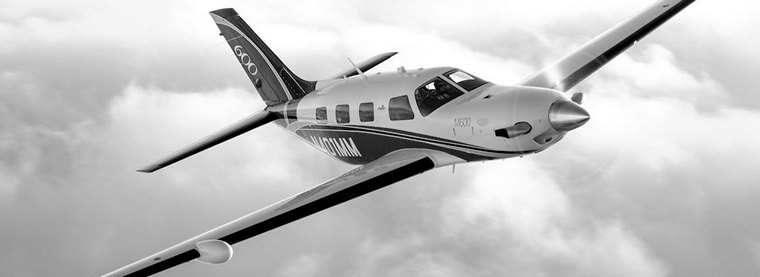 Photo © Piper “The Piper M350 is the only current production pressurized piston-engine aircraft now on the market, making type certification by EASA an important achievement,” said Simon Caldecott, President and CEO of Piper Aircraft. “The single-engine aircraft is a key part of our focus on product improvement and offers the advanced safety features that set our aircraft apart and gives our customers peace of mind.” Equipped with the Garmin 1000 avionics suite, the M350 features electronic stability protection, underspeed protection, coupled go around and automatic level mode. The M350 is also equipped with emergency decent mode which is a significant safety feature that automatically descends the aircraft to lower levels in the rare case the pilot is incapacitated at altitudes where oxygen is required. The Piper M350 seats six with club seating and is powered by a Lycoming TIO-540-AE2A 350 horsepower engine allowing 213 KTAS / 395 km/h max cruise speed at up to 25,000 feet. The cockpit features dual 10.4-inch PFDs and a high-resolution, 12.4 inch MFD along with a GFC700 autopilot. UPGRADED JAGUAR (DARIN III) AIRCRAFT CLOSE TO INITIAL OPERATIONAL CLEARANCE 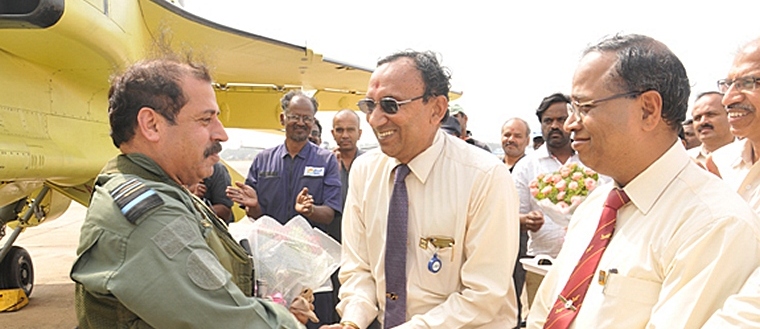 Mr D.K Venkatesh, Director (Engg. and R & D)-HAL greeting Air Marshal RKS Bhadauria, AVSM, VM, DCAS after successful flight of upgraded Jaguar DARIN III at HAL airport, Bengaluru. Mr. R Kaveri Renganathan, CEO. Photos © HAL Air Marshal RKS Bhadauria, AVSM, VM, Dy. Chief of the Air Staff, flew the upgraded Jaguar DARIN-III twin-seat aircraft at HAL airport recently and announced satisfactory completion of Initial Operation Clearance (IOC) of Jaguar DARIN III Upgrade. Wg. Cdr. V. Prabhakaran, Test Pilot, ASTE was his co-pilot. The total design and development covering system requirement capture, specification preparation, software, hardware, electrical and mechanical design and development were carried out indigenously at HAL's Mission & Combat System Research & Design Centre (MCSRDC) and aircraft modification was done at Overhaul Division, added Mr. Raju. Mr D.K Venkatesh, Director (Engg. and R & D), Mr. R Kaveri Renganathan, CEO (BC), Air Vice Marshal Sandeep Singh, AVSM, VM, Commandant ASTE and other senior executives witnessed the flight. Besides HAL, certification agencies, trial team of ASTE and other agencies were involved in the upgrade programme.  Air Marshal RKS Bhadauria, AVSM, VM, Dy. Chief of the Air Staff, flew the upgraded Jaguar DARIN-III Three DARIN I Standard Jaguars have been upgraded to DARIN III Standard by HAL. The upgrade incorporates new state of the art avionics architecture including the Open System Architecture Mission Computer (OSAMC), Engine & Flight Instrument System (EFIS), Fire Control Radar, State of the Art Inertial Navigation System with GPS and Geodetic height correction, Solid State Digital Video Recording System (SSDVRS), Solid State Flight Data Recorder (SSFDR), Smart Multi-Function Display (SMD), Radio Altimeter with 20000 ft range, Autopilot with Alt Select & HNAV and Identification of Friend or Foe (IFF). AIRBUS' A350-1000 JETLINER COMPLETES ITS HISTORIC FIRST FLIGHT 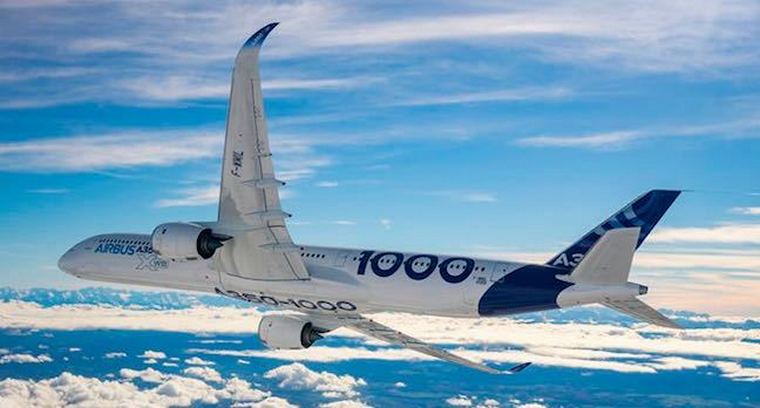 Photo © Airbus The maiden flight of Airbus' A350-1000 - the latest member of the all-new A350 XWB widebody family that is shaping the future of long-haul airline operations - has initiated a fast-paced test and certification programme leading to the jetliner's service entry next year. During more than 4 hours aloft today, this longest-fuselage version of the A350 XWB demonstrated the performance and efficiency that will be appreciated by airline and aircraft leasing customers worldwide - 11 of which already have ordered 195 A350-1000s from the Middle East, North America, Asia, Europe, Latin America and the Caribbean. Performing the initial in-flight evaluation from Toulouse-Blagnac Airport in south western France was the aircraft bearing the Manufacturing Serial Number 59 (MSN059) - one of three jetliners that will participate in the A350-1000 flight test and certification campaign. Measuring nearly 74 metres from nose to tail, the A350-1000 is offering a maximum range of 7,950 nautical miles. It is designed for high efficiency, maximum reliability and optimised performance while offering passengers best-in-class comfort with its “Airspace by Airbus” cabin. The A350-1000's longer fuselage translates to greater capacity, seating 366 passengers (+40 seats compared to the A350-900) in a typical three-class configuration, and answers market needs with a larger premium area to accommodate first class and business class travellers.Further enhancing the A350-1000's efficiency are its latest-generation Rolls-Royce Trent XWB-97 turbofan jet powerplants - the world's most efficient large aero engines flying today. Deliveries of the A350-1000 are planned to begin in the second half of 2017 with launch customer Qatar Airways (which has ordered 37 aircraft). Other carriers that have booked A350-1000s are United Airlines (with 35 on order), Cathay Pacific (26), Etihad (22) British Airways (18), LATAM (14), Japan Airlines (13), Asiana Airlines (10), Air Lease Corporation (9), Virgin Atlantic (8), and Air Caraïbes (3). 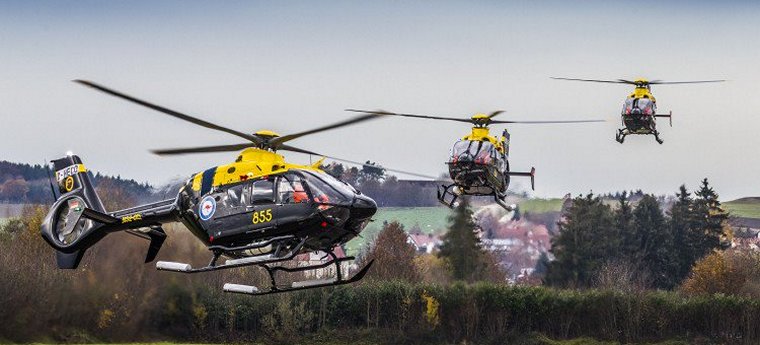 Photo © Airbus Helicopters Under the JP9000 Phase 7 HATS project, a new joint helicopter training program for Navy and Army aircrew will utilise 15 EC135 T2+ helicopters, along with flight simulators and a new flight-deck equipped sea-going training vessel. Boeing Defence Australia is the prime contractor for the new training system, partnered by Thales Australia who supplies the flight simulators and synthetic training devices. A member of the H135 family of light twin-engine helicopters, the EC135 T2+ is an ideal training platform, and initial flying activities have commenced at their new home in Nowra, Australia. “Airbus Helicopters is proud to know that Boeing has accepted now all 15 of their new EC135T2+, on time and on budget, for their world leading helicopter aircrew training system for the ADF”, said Peter Harris, Head of Governmental Sales for Australia - Pacific. “Following contract signature in November of 2014, and in the space of only two years, we have trained the initial cadre of Boeing and Commonwealth aircrew and technicians and all 15 aircraft have now been accepted”. Boeing's HATS Director Terry Nichols said that the Boeing team is very happy with the performance thus far of the EC135 and commended Airbus Helicopters for their on-time delivery. “Boeing Defence Australia chose the EC135 as our preferred helicopter solution for HATS; it's a proven and reliable platform. We have been delighted with the cooperation from Airbus Helicopters to deliver these platforms that will form an important part of a world class training system.” The EC135 T2+ is a consummate military training helicopter, offering a glass cockpit with high visibility, a multi-axis auto-pilot, the performance and safety of a twin-engine helicopter replacing current single types, plus other advanced technologies to help instructors perform training missions safely and provide the ADF with the flexibility to undertake additional missions. The H135 family is part of successful training systems in Germany, Switzerland, Spain and Japan, and has recently been selected in the United Kingdom.  UK, London: A Cathay Pacific Boeing 777-300ER that departed London en route to Hong Kong made an emergency landing in north eastern Russia because of a possible fire Wednesday. The flight with 240 aboard landed at Novosibirsk International Airport after a signal indicated a fire in one of the cargo holds. The warning light went on six hours in the flight. The airline arranged for another plane to pick up the passengers in Russia and transport them to Hong Kong.  3 DECEMBER 1945 An Mk5 Sea Vampire became the first jet aircraft to take off and land from an aircraft carrier, HMS Ocean 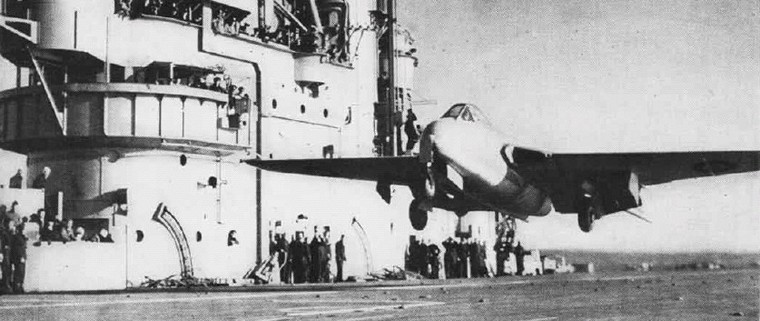 The first carrier landing and takeoff of a jet aircraft in 1945 - Eric "Winkle" Brown taking off from HMS Ocean. Photo commons.wikimedia.org / Public Domain  A Royal Navy Sea Vampire making a touch-and-go landing on the U.S. aircraft carrier USS Antietam. Photo Public Domain / commons.wikimedia.org  Photo Public Domain / commons.wikimedia.org  For a free no obligations quote email sales@pilotspost.com  |
                  |
 |
 |

Copyright © Pilot's Post PTY Ltd
The information, views and opinions by the authors contributing to Pilot's Post are not necessarily those of the editor or other writers at Pilot's Post.